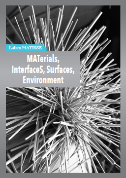Electroactivity in a deep crater lake : microbial vs. mineralogical contributions
Axe 1 - Biominéralisation
Post-doctorat de Jasmine Berg
Mené du 01/01/2017 au 30/06/2018.
Laboratoires co-porteurs
- Institut de minéralogie, de physique des matériaux et de cosmochimie (impmc)
Porteuse de projet : Jennyfer Miot - Chimie de la Matière Condensée de Paris (LCMCP)
Co-encadrante : Christel Laberty-Robert
Projet de recherche
Research Project Microorganisms are important contributors to the reactions driving Fe cycling at redox interfaces in both modern and ancient surface environments on Earth. In particular, iron-reducing, iron-oxidizing and sulfate-reducing bacteria are involved in the formation and alteration of Fe-bearing minerals through their capacity to transfer electrons beyond the cellular surface. Lake Pavin, considered an ancient ocean analogue due to its permanently anoxic, iron-rich (1.2 mM) bottom waters, hosts a wide diversity of potentially electroactive bacteria involved in Fe cycling. We aimed to investigate this unexplored diversity of electroactive environmental bacteria by enriching microorganisms from several water column depths on iron minerals and in microbial fuel cells, with electrodes replacing Fe(III) as the electron acceptor.
Scientific results
To investigate the metabolic potential of the Lake Pavin bacterial community, we constructed 16S rRNA gene amplicon libraries from at and below the oxycline and attempted to cultivate some of these microorganisms. Despite low endogenous sulfate concentrations (< 20 µM), highly diverse populations of sulfur-reducing and sulfur-oxidizing bacteria represented up to 10 % and 5 % of the total recovered sequences, respectively, which together was roughly equivalent to the fraction of putative iron cycling bacteria. Enrichment cultures were amended with the key iron species identified in situ, namely ferric iron phosphate, ferrihydrite, and dissolved Fe2+. These different iron phases, the type of electron donor (lactate, acetate, or fumarate), and the presence or absence of added sulfate favored the development of unique Fe-reducing microbial communities. Surprisingly, sulfate-reducers were the most competitive organisms in our enrichments containing sulfate and transformed ferric iron into a diversity of ferrous minerals depending on Fe(III) source (e.g. mackinawite, vivianite, magnetite). Additional characterization of the resulting iron minerals with EXAFS and STXM revealed that the proportion of reduced iron varied with the phase of iron supplied as well as with the electron donor and that microbial cells were intimately associated with reduced iron minerals. Our findings reveal an important influence of microbial activity on mineralogical diversity through both direct and indirect biomineralization pathways. Characterization of electroactive microbial communities enriched on electrodes is underway.
Posters
- “Insights into microbial sulfur cycling in ferruginous, low-sulfate waters” 5th International Symposium on Microbial Sulfur Metabolism, 16-18 April 2018. Vienna, Austria.
Oral Presentations
- “Direct and indirect biomineralization of iron in the ferruginous Lake Pavin” Goldschmidt, 13-17 Aug 2018. Boston, USA.
- “Diversity-specific iron biomineralization in an Archean ocean analogue” GeoBremen, 25-27 Oct 2017. Bremen, Germany.
Publications
- Jasmine Berg, Didier Jézéquel, Arnaud Duverger, Dominique Lamy, Christel Laberty et al.
Microbial diversity involved in iron and cryptic sulfur cycling in the ferruginous, low-sulfate waters of Lake Pavin
PLoS ONE, Public Library of Science, 2019, 14 (2), pp.e0212787.
DOI : 10.1371/journal.pone.0212787
HAL Id : hal-02066354v1
Egalement dans la rubrique
- Anomalie strontique du plancton calcaire : approche biogéochimique et minéralogique
- Formation des racines calcifiées (rhizolithes) dans les sédiments terrestres
- Quels complexes organo-minéraux assurent la stabilisation pluri-décennale du carbone dans les sols ?
- Reaction networks and aqueous stability of RNA elementary bricks in realistic prebiotic conditions
- Toward a microfluidic model to understand pathological renal microcalcifications
MATISSE en chiffres
- 4 disciplines : Chimie, Physique, Sciences de la Terre, Patrimoine
- 400 permanents
Contact
Direction
Florence Babonneau
Administration
Communication
Emmanuel Sautjeau



